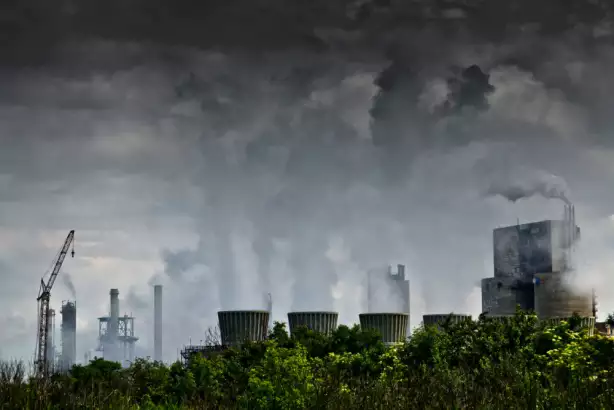What are the key features of an RTO for air pollution control?
はじめに
– Regenerative Thermal Oxidizers (RTOs) are widely used for air pollution control in various industries.
– They are engineered systems designed to destroy volatile organic compounds (VOCs) and hazardous air pollutants (HAPs) emitted during industrial processes.
– RTOs are known for their high efficiency and cost-effectiveness in reducing air pollution.
Operating Principle
– RTOs work based on the principle of thermal oxidation, which involves the combustion of pollutants at high temperatures.
– The process takes place in a combustion chamber, where VOCs and HAPs are exposed to a high-temperature airstream.
– The combustion chamber contains ceramic media beds that act as a heat exchange medium and help optimize energy efficiency.
Main Features of an RTO
1. Heat Recovery System
– RTOs are equipped with a heat recovery system that allows capturing and reusing the heat generated during the combustion process.
– This feature significantly reduces fuel consumption and operating costs.
– The recovered heat is transferred to the incoming polluted airstream, preheating it before entering the combustion chamber.
2. Ceramic Media Beds
– RTOs utilize ceramic media beds to enhance heat transfer efficiency.
– The media beds have a high thermal mass, allowing them to store and release heat effectively.
– The media also provides a large surface area for the oxidation reaction to occur, maximizing pollutant destruction.
3. Flow Control System
– RTOs incorporate a flow control system to regulate the direction and volume of the airstream.
– This system ensures proper heat exchange and prevents overheating or underheating of the media beds.
– By maintaining optimal operating conditions, the flow control system enhances the overall performance of the RTO.
4. Combustion Chamber Design
– The combustion chamber of an RTO is carefully designed to facilitate efficient combustion and pollutant destruction.
– It is insulated to minimize heat loss and maintain high temperatures within the chamber.
– The chamber may also include features like turbulence promoters or mixing zones to enhance the mixing of pollutants with the airstream.
5. Control and Monitoring Systems
– RTOs are equipped with advanced control and monitoring systems to ensure optimal performance and safety.
– These systems continuously monitor key parameters such as temperature, pressure, and airflow.
– They allow for precise control of the combustion process, ensuring efficient pollutant destruction and compliance with environmental regulations.
結論
– Regenerative Thermal Oxidizers (RTOs) play a crucial role in air pollution control by effectively destroying volatile organic compounds (VOCs) and hazardous air pollutants (HAPs) emitted during industrial processes.
– The key features of an RTO, including the heat recovery system, ceramic media beds, flow control system, combustion chamber design, and control and monitoring systems, contribute to their high efficiency and effectiveness in reducing air pollution.
– By utilizing these features, industries can mitigate their environmental impact and ensure compliance with air quality regulations.
[](https://regenerative-thermal-oxidizers.com/wp-content/uploads/2024/10/0-air-pollution-control-rto-4.webp)
[](https://regenerative-thermal-oxidizers.com/wp-content/uploads/2023/12/0_rto-11.webp)
Key Features of an RTO for Air Pollution Control
Our company is a high-tech enterprise specializing in the comprehensive treatment of volatile organic compounds (VOCs) emissions and carbon reduction energy-saving technology. We have four core technologies: thermal energy, combustion, sealing, and self-control. Additionally, we possess capabilities in temperature field simulation, air flow field simulation modeling, ceramic heat storage material performance, molecular sieve adsorption material selection, and VOCs high-temperature incineration oxidation experimental testing.
チームのメリット
We have established an RTO technology research and development center and an exhaust gas carbon reduction engineering technology center in Xi’an, as well as a 30,000 square meter production base in Yangling. As a leading manufacturing enterprise in terms of RTO equipment and molecular sieve rotary wheel equipment, our core technical team comes from the Aerospace Liquid Rocket Engine Research Institute (Aerospace No. 6 Institute). Currently, our company has more than 360 employees, including over 60 research and development technical backbones. Among them, there are three senior engineers with the title of research fellow, six senior engineers, and 47 thermodynamics doctors.
コア製品
Our core products include the rotary valve regenerative thermal oxidation furnace (RTO) and the molecular sieve adsorption concentration rotary wheel. Combined with our expertise in environmental protection and thermal energy system engineering, we can provide customers with comprehensive solutions for industrial waste gas treatment and carbon reduction through heat energy utilization under various operating conditions.

認定、特許、栄誉
- 知的財産管理システム認証
- 品質管理システム認証
- 環境マネジメントシステム認証
- Construction Enterprise Qualification
- ハイテク企業
- Patents for Rotary Valve Regenerative Thermal Oxidation Furnace
- Patents for Rotary Wheel Heat Storage Incineration Equipment
- Patents for Disc Molecular Sieve Rotary Wheel
適切な RTO 機器の選び方
1. Determine the characteristics of the waste gas.
2. Understand the local regulations and emission standards.
3. Evaluate energy efficiency.
4. Consider operation and maintenance.
5. Budget and cost analysis.
6. Select the appropriate type of RTO.
7. Consider environmental and safety factors.
8. Perform performance testing and verification.

RTO Air Pollution Control Service Process
1. Preliminary consultation, on-site investigation, and needs analysis.
2. Solution design, simulation and modeling, and solution review.
3. Customized production, quality control, and factory testing.
4. On-site installation, commissioning, and training services.
5. Regular maintenance, technical support, and spare parts supply.
We are a one-stop solution provider for RTO air pollution control, with a professional team dedicated to customizing RTO solutions for our customers.
著者宮
